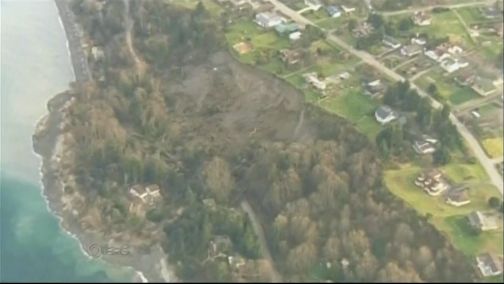
Glacial Legacy Set Stage for Washington Landslide

With a loud roar, a seaside cliff collapsed into the ocean yesterday on Washington's Whidbey Island, destroying a home and threatening some 30 more.
The 1,000-foot (300 meter) slide broke free about 4 a.m. local time, waking residents and sending one man fleeing from his house, which now sits on the beach. Damage occurred to a road leading to beachfront homes and power and utility lines, according to the Seattle Times.
January through March is landslide season in the Pacific Northwest, according to the Washington Department of Ecology, as heavy rains soak unstable sediments, provoking landslides. The shifty sediments are a legacy of glaciers scouring the region between 2 million and 10,000 years ago, leaving rubbly piles, sand and clay that haven't yet become rock. Steep sea cliffs prone to slides have formed as the land rebounds from the weight of the glacial ice, as well as further boosts from earthquakes.
Whidbey Island is long and narrow, about 35 miles (56 kilometers) from tip to tip, and many of its steep slopes are prone to slumping landslides, according to the Department of Ecology.
Slumps occur when groundwater concentrates near underground silt or clay layers. The saturated zone can let upper layers slide, sometimes with accompanying rotation. The soil moves as a giant block, with the clay acting as a slippery ramp.
About 18,000 years ago, glacial lakes laid down a thick, impenetrable clay layer on Whidbey Island, according to a geology field guide written by Terry Swanson, a geomorphologist at the University of Washington. Above the clay are fine-grained sediments and sands. The top layer is glacial till, the messy piles left behind as glaciers plow across a landscape.
Water seeping downward hits the clay and can't go any further, saturating the finer sediments above. This greatly increases the likelihood of landslides during excessively wet winters on Whidbey Island, the field guide said.
Sign up for the Live Science daily newsletter now
Get the world’s most fascinating discoveries delivered straight to your inbox.
Email Becky Oskin or follow her @beckyoskin. Follow us @OAPlanet, Facebook or Google +. Original article on LiveScience's OurAmazingPlanet.











